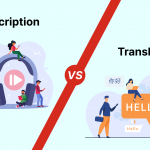
Language, a dynamic and ever-evolving phenomenon, continually introduces new words and phrases into its vocabulary. With over 7,000 spoken languages established in the history of human civilization, the complexity of language poses a challenge for Automatic Speech Recognition (ASR) service providers. This article explores the difficulties faced by ASR providers in keeping their language models current with evolving terminology and usage.
What is ASR?
Automatic Speech Recognition (ASR) is a technology that converts spoken language into written text. By utilizing complex algorithms and linguistic patterns, ASR systems transcribe spoken words into readable text, making it valuable for various applications like transcription services, virtual assistants, and voice-controlled devices.
ASR technology plays a pivotal role in enhancing accessibility and convenience, allowing seamless interaction between humans and machines through speech.
The Evolution of Language:
Language, in both spoken and written forms, boasts a rich history evolving over thousands of years. The present linguistic landscape, characterized by immense diversity, poses a challenge for Automatic Speech Recognition (ASR) providers. Staying current with the ever-changing nuances of language is essential.
Modern variations, slang, and new terms constantly emerge, demanding continuous adaptation from ASR technology. As languages evolve, ASR providers must navigate this complexity, ensuring their systems accurately capture the subtleties of communication.
Adapting to these linguistic shifts enables ASR providers to deliver more precise and effective speech recognition services, bridging the gap between evolving language patterns and technology.
Need for Regular Updates:
ASR service providers must continuously update their models to enhance recognition accuracy.
This involves training models on diverse datasets and introducing new features. However, there is always a time lag between identifying new terms and incorporating them into training data, making real-time accuracy challenging.
Impact of Social Media:
Words popularized through social media, such as “selfie,” “hashtag,” and “reels,” organically find their way into language models during updates. Although these terms have gained popularity, their occasional use doesn’t significantly impact word-error rates, making immediate integration into ASR models less critical.
Challenges in Data Collection:
High-quality speaking data is crucial for training language models. While adding more data might seem like a solution, it’s essential to avoid introducing bias or low-quality data. ASR providers face challenges in obtaining and maintaining the right kind of data to ensure accurate transcriptions without compromising user privacy.
Unprecedented Popularity of Terms:
Certain terms like “Brexit” and “COVID-19” have gained rapid and widespread usage. These terms, prevalent in various channels from media to social platforms, significantly impact word-error rates when transcribed. Their prominence in texts amplifies the challenge for ASR providers to ensure accurate recognition.
Conclusion:
Adapting to the changing language landscape is a complex task for ASR service providers. Balancing the need for real-time accuracy with data quality and user privacy is essential. While some words naturally integrate into language models, unprecedented events like the COVID-19 pandemic highlight the necessity for rapid adaptation. ASR providers must continue refining their methods to meet the evolving linguistic demands of the digital age.
Voxtab is here to help you out! Our expert team transcends linguistic accuracy, delivering context and meaning tailored to 50 different specialties. Whether you’re in business, academia, law, or medicine, trust us for precise, culturally sensitive solutions.
Visit our website to learn more by clicking on the link.








Share your thoughts